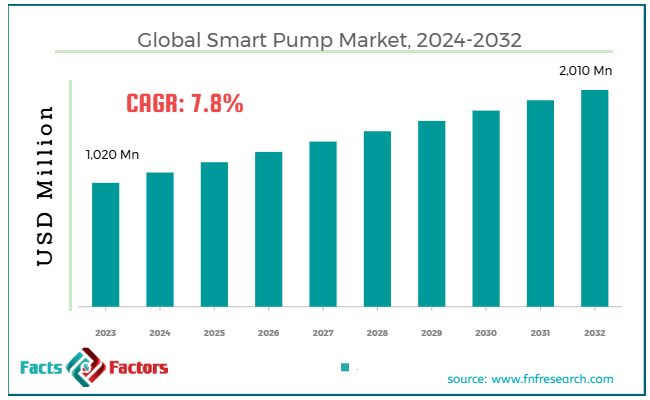Search Market Research Report
Smart Pump Market Size, Share Global Analysis Report, 2024 – 2032

Smart Pump Market Size, Share, Growth Analysis Report By Type (Centrifugal, Positive Displacement), By Component (Pumps, Variable Drives, Control Systems), By End-User (Building Automation, Water & Wastewater, Oil & Gas, Chemicals, Power Generation, and Others), And By Region - Global Industry Insights, Overview, Comprehensive Analysis, Trends, Statistical Research, Market Intelligence, Historical Data and Forecast 2024 – 2032
Industry Insights
[212+ Pages Report] According to Facts & Factors, the global smart pump market size was worth around USD 1,020 million in 2023 and is predicted to grow to around USD 2,010 million by 2032, with a compound annual growth rate (CAGR) of roughly 7.8% between 2024 and 2032.

 Market Overview
Market Overview
A smart pump is an advanced pump system that integrates controllers, sensors, and communication technologies to manage and monitor the flow of fluids in a better way. It can effectively adjust and perform depending on factors like temperature, pressure, and flow rate, aiding to decrease maintenance costs and optimize energy usage.
The global smart pump market is projected to witness considerable growth in the future owing to the growing demand for predictive maintenance and remote monitoring, rising industrial automation, and growing demand for energy-efficient solutions. The rising emphasis on energy efficiency in diverse industries is the leading driver of the market. Smart pumps can effectively adjust their functioning on the basis of demand, thus reducing operational costs.
Furthermore, the rising adoption of IoT and automation is driving the demand for smart pumps. These pumps may be linked to IoT networks for data collection, remote monitoring, and analysis, resulting in proactive maintenance and enhanced decision-making.
However, complex installation, maintenance, and data privacy concerns are some of the key hampering factors to the market growth. The installation of smart pumps may be challenging, thus needing integration with the current systems and technicians. This could elevate the total operational costs and bring more challenges to the maintenance, mainly for conventional systems.
Moreover, since smart pumps are mostly incorporated into IoT networks, they are prone to risks to confidential operational data, resulting in possible operational disturbances. Nevertheless, the global smart pump industry is opportune to the rising demand for predictive maintenance and growth in developing regions. The ability to analyze and monitor pump performance in real-time enables operators to forecast maintenance requirements prior to problems occurring. This considerably reduces downtime and avoids costly repairs.
Hence, as predictive maintenance technologies are witnessing higher demand, this denotes a key opportunity for the global market. Also, the emerging economies, mainly Africa and Asia-Pacific are witnessing speedy urbanization and industrialization.
Since these regions are actively investing in infrastructure, the demand for smart water management along with energy-efficient solutions, offers prospects for smart pumps.
 Key Insights:
Key Insights:
- As per the analysis shared by our research analyst, the global smart pump market is estimated to grow annually at a CAGR of around 7.8% over the forecast period (2024-2032)
- In terms of revenue, the global smart pump market size was valued at around USD 1,020 million in 2023 and is projected to reach USD 2,010 million by 2032.
- The smart pump market is projected to grow significantly owing to growing demand for energy efficiency, rising environmental concerns, and growing industrial automation and IoT integration.
- Based on type, the centrifugal segment is expected to lead the market, while the positive displacement segment is expected to register considerable growth.
- Based on component, the pumps segment is the dominating segment among others, while the control systems segment is projected to witness sizeable revenue over the forecast period.
- Based on end-user, the water & wastewater segment is expected to lead the market as compared to the building automation segment.
- Based on region, North America is projected to dominate the global market during the estimated period, followed by Europe.
 Growth Drivers
Growth Drivers
- Digitalization and industrial automation boost the smart pump market growth
The growth of digitalization and Industry 4.0 has increased the significance of automation, mainly in industries like water treatment, manufacturing, and oil & gas. Smart pumps hold a key role in the automation wave by allowing data analytics, remote monitoring, and real-time upgrading of pump operations. The global smart pump industry is anticipated to progress considerably over the next decade with a CAGR of 7.8%. As industries and businesses continue to implement digitalization, the demand for automation systems like smart pumps is also rising.
Leading companies like Schneider Electric and Siemens are incorporating smart pumps with their automation platforms. For instance, recently, Siemens introduced a fresh digital solution for water utilities, joining IoT-based pumps with enhanced analytics for better operational efficiency and asset management.
- Sustainability and energy efficiency initiatives impact market growth
There is a rising focus on sustainability and energy efficiency in industries, impacted by environmental and economic concerns. Smart pumps are specially designed to improve the use of energy, minimize carbon footprints, and decrease operational costs.
With the ever-increasing energy prices and stringent regulations, businesses are actively shifting to using smart pumps as an efficient solution to fulfill sustainability objectives. The global market is anticipated to gain substantial growth, propelled by the rising demand for energy-efficient technologies. The use of energy-saving pumps significantly decreases the consumption of energy by nearly 30-40% in diverse industrial applications.
The Energy Efficient Directive and European Green Deal are forcing industries to adopt clean technologies and here, smart pumps are playing a vital role in assisting businesses obey these protocols. For example, recently, Grundfos introduced an energy-saving pump product line that decreases energy consumption by nearly 50% than conventional pumps.
 Restraints
Restraints
- Maintenance and reliability negatively impact the progress of the smart pump market
While smart pumps are dedicated to enhancing efficiency, their dependency on software, connectivity, and sensors may result in significant maintenance needs. If the sensors fail or the software breaks down, the whole system may become undependable.
As per reports, the maintenance cost of smart pumps is approximately 15% higher than conventional pumps. This is mainly due to the challenges in maintaining software updates and sensors.
In 2023, Grundfos witnessed a backslash concerning problems with a smart pump named, Flygt Concertor, wherein a few customers witnessed disturbances due to sensor breakdown. This increased issues over the long-term maintenance needs and reliability of smart pump systems. Yet, concerns about reliability still prevail, despite the company upgrading the quality of the product.
 Opportunities
Opportunities
- Development of the renewable energy sector to fuel the smart pump market growth
The renewable energy sector, comprising solar, wind, and hydroelectric power, denotes major prospects for smart pumps. Smart pumps are vital for systems, such as hydropower generation, wherein smooth water flow management is essential.
Likewise, they are becoming important in most renewable energy uses and geothermal power plants. The demand for smart and energy-efficient technologies is projected to rise by nearly 10% annually.
Sulzer has been increasing its smart pump solutions, particularly for renewable energy applications, mainly for geothermal and hydropower plants. These pumps ensure the consistency of fluid systems in energy production, which optimizes the generation of renewable energy processes.
 Challenges
Challenges
- Challenges concerning integration with conventional systems restrict the growth of the smart pump market
Integrating smart pumps in the current industrial arrangements, mainly in traditional facilities with legacy infrastructure might be expensive and challenging. Most industries are still dependent on older control systems and machinery, which may not be easily compatible with the technologically improved systems, resulting in integration problems.
Schneider Electric and Siemens companies launched digital integration platforms to help smooth the assimilation of smart pumps in the current operations. But, the challenge of retrofitting in traditional systems still prevails. Most businesses in developing markets lack the infrastructure to aid the digital transition needed for the adoption of smart pumps.
 Report Scope
Report Scope
Report Attribute |
Details |
Market Size in 2023 |
USD 1,020 Million |
Projected Market Size in 2032 |
USD 2,010 Million |
CAGR Growth Rate |
7.8% CAGR |
Base Year |
2023 |
Forecast Years |
2024-2032 |
Key Market Players |
ABB Ltd., Grundfos, Xylem Inc., KSB SE & Co. KGaA, Flowserve Corporation, Emerson Electric Co., Schneider Electric, Danfoss, Sulzer Ltd., Pentair, Wilo SE, ITT Inc., HERMETIC-Pumpen GmbH, Seko S.p.A., ClydeUnion Pumps, and Others. |
Key Segment |
By Type, By Component, By End-User, and By Region |
Major Regions Covered |
North America, Europe, Asia Pacific, Latin America, and the Middle East &, Africa |
Purchase Options |
Request customized purchase options to meet your research needs. Explore purchase options |
 Segmentation Analysis
Segmentation Analysis
The global smart pump market is segmented based on type, component, end-user, and region.
Based on type, the global smart pump industry is divided into centrifugal and positive displacement. In 2023, the centrifugal segment held a notable share of the market and is projected to continue dominance in the future as well. Its prominence is backed by its dominance in industrial applications, versatility and cost-effectiveness, and ease of integration with smart solutions.
Centrifugal pumps are prominently used in diverse industries like chemical processing, water treatment, and HVAC owing to their efficacy in managing huge quantities of liquid. They are usually more budget-friendly than positive displacement and provide the least to moderate pressure. This makes them suitable for applications that demand continuous flow.
Moreover, smart technology can be smoothly integrated into centrifugal pumps. This is because of their wide applications in industries that already use IoT and automation for predictive maintenance and real-time monitoring.
Based on component, the global smart pumps industry is segmented into pumps, variable drives, and control systems. The pumps segment is anticipated to lead the market over the forecast period owing to its integration with smart technologies and broad applications. The overall industry is fueled by the rising adoption of smart pumps in diverse industries. These pumps incorporate enhanced sensors, automated control systems, and IoT connectivity that allow predictive maintenance, real-time monitoring, and energy efficiency.
Furthermore, positive displacement and centrifugal pumps that are embedded with smart technologies, help different sectors like oil and gas, water treatment, HVC, food and beverages, and pharmaceuticals, thus their dominance.
Based on end-user, the global smart pump market is segmented as building automation, water & wastewater, oil & gas, chemicals, power generation, and others. In 2023, the water & wastewater segment held a majority share and will continue its dominance over the forecast period owing to the growing demand for smart water management and regulatory pressure. These pumps are essential for water treatment plants, sewage systems, and desalination facilities that demand efficient water flow, effective operation, and optimized energy usage.
Also, the rising demand for energy-efficient systems in the distribution sector and water treatment plans to improve water quantity and decrease energy usage. The incorporation of smart pumps allows data-based decision-making and real-time monitoring, resulting in enhanced water management.
Also, governments are imposing strict energy efficiency standards for the water and wastewater domain. This motivates end users to use smart water meters to ensure sustainability and decrease operating costs.
 Regional Analysis
Regional Analysis
- North America to witness significant growth over the forecast period
North America leads the global smart pump market owing to technological improvements, a growing focus on energy efficiency, and regulatory support. The key economies, including Canada and the United States, are leading in terms of the adoption of enhanced technologies like automation, artificial intelligence, and the industrial Internet of Things. These technologies are vital for smart pumps. The region holds a sophisticated industrial infrastructure that smoothly integrates smart technology.
Also, the demand for energy-saving solutions in industries like chemicals, oil and gas, and water treatment is rising. This complies with the region's initiative for energy sustainability. Furthermore, stringent energy efficiency and environmental regulations in North America motivate industries to use smart pumps to decrease emissions and obey standards.
Europe also holds a substantial share of the global market owing to its focus on sustainability, developed industrial base, and green initiatives and regulatory support. The majority of nations in the region hold a strong commitment to sustainability, reducing carbon emissions, and energy efficiency.
Europe also has an assorted industrial base, comprising water treatment, chemical processing, manufacturing, and automotive sectors, which use smart pumps on a large scale. Nations like France, Germany, and the United Kingdom have strong industrial sectors, thus majorly impacting market growth.
Moreover, the European Union's policies like European Green Deal, focus on reducing emissions and clean energy, thus motivating the use of energy efficiency solutions like smart pumps. These regulations on energy consumption further fuel the global market demand.
 Competitive Analysis
Competitive Analysis
The global smart pump industry is led by players like:
- ABB Ltd.
- Grundfos
- Xylem Inc.
- KSB SE & Co. KGaA
- Flowserve Corporation
- Emerson Electric Co.
- Schneider Electric
- Danfoss
- Sulzer Ltd.
- Pentair
- Wilo SE
- ITT Inc.
- HERMETIC-Pumpen GmbH
- Seko S.p.A.
- ClydeUnion Pumps
 Key Market Trends
Key Market Trends
- Integration with cloud and IoT technology:
Smart pumps are currently embedded with cloud-based platforms and IoT. This allows real-time monitoring, remote diagnostics, and data collection, which improves predictive maintenance capabilities and operational efficiency.
- Rise of robotics and automation:
Smart pumps are also integrating machine learning and artificial intelligence algorithms to anticipate failures before happening. This ultimately decreases maintenance costs and downtime. Predictive maintenance is a vital characteristic for ensuring operational efficiency and extended pump lifecycles.
The global smart pump market is segmented as follows:
 By Type Segment Analysis
By Type Segment Analysis
- Centrifugal
- Positive Displacement
 By Component Segment Analysis
By Component Segment Analysis
- Pumps
- Variable Drives
- Control Systems
 By End-User Segment Analysis
By End-User Segment Analysis
- Building Automation
- Water & Wastewater
- Oil & Gas
- Chemicals
- Power Generation
- Others
 By Regional Segment Analysis
By Regional Segment Analysis
- North America
- The U.S.
- Canada
- Mexico
- Europe
- France
- The UK
- Spain
- Germany
- Italy
- Rest of Europe
- Asia Pacific
- China
- Japan
- India
- Australia
- Southeast Asia
- Rest of Asia Pacific
- The Middle East & Africa
- Saudi Arabia
- UAE
- Egypt
- Kuwait
- South Africa
- Rest of the Middle East & Africa
- Latin America
- Brazil
- Argentina
- Rest of Latin America
Industry Major Market Players
- ABB Ltd.
- Grundfos
- Xylem Inc.
- KSB SE & Co. KGaA
- Flowserve Corporation
- Emerson Electric Co.
- Schneider Electric
- Danfoss
- Sulzer Ltd.
- Pentair
- Wilo SE
- ITT Inc.
- HERMETIC-Pumpen GmbH
- Seko S.p.A.
- ClydeUnion Pumps
Frequently Asked Questions

Copyright © 2024 - 2025, All Rights Reserved, Facts and Factors


